Polarization-Discriminated RSOA–EAM for Colorless Transmitter in WDM–PON
Abstract
1. Introduction
2. Device Structure and Working Principle
3. Simulation Results and Discussion
3.1. Downstream Signal Suppression
3.2. Upstream Signal Integrity and Power
4. Conclusions
Supplementary Materials
Author Contributions
Funding
Conflicts of Interest
References
- Banerjee, A.; Park, Y.; Clarke, F.; Song, H.; Yang, S.; Kramer, G.; Kim, K.; Mukherjee, B. Wavelength-division-multiplexed passive optical network (WDM-PON) technologiesfor broadband access: A review. J. Opt. Netw. 2005, 4, 737–758. [Google Scholar] [CrossRef]
- An, F.-T.; Kim, K.S.; Gutierrez, D.; Yam, S.; Hu, E.; Shrikhande, K.; Kazovsky, L.G. Success: A next-generation hybrid WDM/TDM optical access network architecture. J. Lightwave Technol. 2004, 22, 2557–2569. [Google Scholar] [CrossRef]
- Feldman, R.D.; Harstead, E.; Jiang, S.; Wood, T.H.; Zirngibl, M. An evaluation of architectures incorporating wavelength division multiplexing for broad-band fiber access. J. Lightwave Technol. 1998, 16, 1546. [Google Scholar] [CrossRef]
- An, F.-T.; Kim, K.S.; Hsueh, Y.-L.; Rogge, M.; Shaw, W.-T.; Kazovsky, L. Evolution, challenges and enabling technologies for future WDM-based optical access networks. In Proceedings of the 2nd Symposium on Photonics, Networking, and Computing, Cary, NC, USA, 26–30 September 2003; pp. 26–30. [Google Scholar]
- Wey, J.S.; Zhang, J. Passive Optical Networks for 5G Transport: Technology and Standards. J. Lightwave Technol. 2019, 37, 2830–2837. [Google Scholar] [CrossRef]
- Lu, Y.; Huang, G.; Bi, M.; Hu, M.; Yang, G.; Zhou, X. Flexible migration and colorless ONUs for future PON based on simple line-coding. Opt. Fiber Technol. 2019, 49, 57–63. [Google Scholar] [CrossRef]
- Park, S.; Jung, D.K.; Shin, D.J.; Shin, H.S.; Yun, I.K.; Lee, J.S.; Oh, Y.K.; Oh, Y.J. Colorless Operation of WDM-PON Employing Uncooled Spectrum-Sliced Reflective Semiconductor Optical Amplifiers. IEEE Photon. Technol. Lett. 2007, 19, 248–250. [Google Scholar] [CrossRef]
- Cikan, N.N.; Aksoy, M. A Review of Self-Seeded RSOA Based on WDM PON. Can. J. Electr. Comput. Eng. 2019, 42, 2–9. [Google Scholar] [CrossRef]
- Gebrewold, S.A.; Bonjour, R.; Brenot, R.; Hillerkuss, D.; Leuthold, J. Bit- and Power-Loading—A Comparative Study on Maximizing the Capacity of RSOA Based Colorless DMT Transmitters. Appl. Sci. 2017, 7, 999. [Google Scholar] [CrossRef]
- Wong, E.; Lee, K.L.; Anderson, T.B. Directly modulated self-seeding reflective semiconductor optical amplifiers as colorless transmitters in wavelength division multiplexed passive optical networks. J. Lightwave Technol. 2007, 25, 67–74. [Google Scholar] [CrossRef]
- Zhan, W.; Zhou, P.; Zeng, Y.; Mukaikubo, M.; Tanemura, T.; Nakano, Y. Optimization of Modulation-Canceling Reflective Semiconductor Optical Amplifier for Colorless WDM Transmitter Applications. J. Lightwave Technol. 2017, 35, 274–279. [Google Scholar] [CrossRef]
- Atra, K.; Cerulo, G.; Provost, J.; Jorge, F.; Blache, F.; Mekhazni, K.; Garreau, A.; Pommereau, F.; Gomez, C.; Fortin, C.; et al. O-Band Reflective Electroabsorption Modulator for 50 Gb/s NRZ and PAM-4 Colorless Transmission. In Proceedings of the 2020 Optical Fiber Communications Conference and Exhibition (OFC), San Diego, CA, USA, 8–12 March 2020; pp. 1–3. [Google Scholar]
- Kim, H.-S.; Kim, D.C.; Kim, K.-S.; Choi, B.-S.; Kwon, O.K. 10.7 Gb/s reflective electroabsorption modulator monolithically integrated with semiconductor optical amplifier for colorless WDM-PON. Opt. Express 2010, 18, 23324–23330. [Google Scholar] [CrossRef]
- Smith, D.; Lealman, I.; Chen, X.; Moodie, D.; Cannard, P.; Dosanjh, J.; Rivers, L.; Ford, C.; Cronin, R.; Kerr, T. Colourless 10 Gb/s reflective SOA-EAM with low polarization sensitivity for long-reach DWDM-PON networks. In Proceedings of the 2009 35th European Conference on Optical Communication (ECOC), Vienna, Austria, 20–24 December 2009. [Google Scholar]
- Cho, K.; Choi, B.; Takushima, Y.; Chung, Y. 25.78-Gb/s operation of RSOA for next-generation optical access networks. IEEE Photonics Technol. Lett. 2011, 23, 495–497. [Google Scholar] [CrossRef]
- Lee, W.; Park, M.Y.; Cho, S.H.; Lee, J.; Kim, C.; Jeong, G.; Kim, B.W. Bidirectional WDM-PON based on gain-saturated reflective semiconductor optical amplifiers. IEEE Photonics Technol. Lett. 2005, 17, 2460–2462. [Google Scholar]
- Papagiannakis, I.; Omella, M.; Klonidis, D.; Lázaro Villa, J.A.; Birbas, A.N.; Kikidis, J.; Tomkos, I.; Prat, J. Design Characteristics for a Full-Duplex IM/IM Bidirectional Transmission at 10 Gb/s Using Low Bandwidth RSOA. J. Lightwave Technol. 2010, 28, 1094–1101. [Google Scholar] [CrossRef]
- Schrenk, B.; Bonada, F.; Lazaro, J.A.; Prat, J. Remotely Pumped Long-Reach Hybrid PON With Wavelength Reusein RSOA-Based ONUs. J. Lightwave Technol. 2011, 29, 635–641. [Google Scholar] [CrossRef]
- Dúill, S.Ó.; Marazzi, L.; Parolari, P.; Brenot, R.; Koos, C.; Freude, W.; Leuthold, J. Efficient modulation cancellation using reflective SOAs. Opt. Express 2012, 20, B587–B594. [Google Scholar] [CrossRef] [PubMed]
- Gebrewold, S.; Bonjour, R.; Barbet, S.; Maho, A.; Brenot, R.; Chanclou, P.; Brunero, M.; Marazzi, L.; Parolari, P.; Totovic, A.; et al. Self-Seeded RSOA-Fiber Cavity Lasers vs. ASE Spectrum-Sliced or Externally Seeded Transmitters—A Comparative Study. Appl. Sci. 2015, 5, 1922. [Google Scholar] [CrossRef]
- Gebrewold, S.A.; Marazzi, L.; Parolari, P.; Brenot, R.; Dúill, S.P.Ó.; Bonjour, R.; Hillerkuss, D.; Hafner, C.; Leuthold, J. Reflective-SOA Fiber Cavity Laser as Directly Modulated WDM-PON Colorless Transmitter. IEEE J. Sel. Top. Quantum Electron. 2014, 20, 503–511. [Google Scholar] [CrossRef]
- Zuo, C.; Li, X.; Xia, Y.; Dai, X.; Wang, L. Horn-Waveguide RSOA-EAM as a Colorless Emitting Source with Reduced Crosstalk. J. Lightwave Technol. 2018, 36, 5942–5948. [Google Scholar] [CrossRef]
- Ribeiro, N.S.; Cavalcante, A.R.; Gallep, C.M.; Conforti, E. Data Rewriting After Carrier Erasing by Ultra-Long SOA. In Proceedings of the Optical Fiber Communication Conference/National Fiber Optic Engineers Conference 2011, Los Angeles, CA, USA, 6 March 2011; p. JWA042. [Google Scholar]
- Lee, J.H.; Cho, S.; Jang, Y.S.; Lee, S. Enhancement of power budget in RSOA based loop-back type WDM-PON by using the cascaded RSOAs. In Proceedings of the 2010 12th International Conference on Transparent Optical Networks, Munich, Germany, 27 June–1 July 2010; pp. 1–4. [Google Scholar]
- Feng, H.; Ge, J.; Xiao, S.; Fok, M.P. Suppression of Rayleigh backscattering noise using cascaded-SOA and microwave photonic filter for 10 Gb/s loop-back WDM-PON. Opt. Express 2014, 22, 11770–11777. [Google Scholar] [CrossRef]
- Celino, D.R.; Duarte, U.R.; Romero, M.A. Improved self-seeding and carrier remodulation performance for WDM-PON by means of double RSOA erasure. Opt. Commun. 2020, 459, 125018. [Google Scholar] [CrossRef]
- Chi, Y.; Lin, C.; Lin, S.; Lin, G. The Reuse of Downstream Carrier Data Erased by Self-Feedback SOA for Bidirectional DWDM-PON Transmission. J. Lightwave Technol. 2012, 30, 3096–3102. [Google Scholar] [CrossRef]
- Zaman, T.; Guo, X.; Ram, R.J. Waveguide Faraday rotation in Fe: InGaAsP. In Proceedings of the 2006 Conference on Lasers and Electro-Optics and 2006 Quantum Electronics and Laser Science Conference, Long Beach, CA, USA, 21–26 May 2006; pp. 1–2. [Google Scholar]
- Zaman, T.R.; Guo, X.; Ram, R.J. Faraday rotation in an InP waveguide. Appl. Phys. Lett. 2007, 90, 023514. [Google Scholar] [CrossRef]
- Aizawa, T.; Ravikumar, K.G.; Suzaki, S.; Watanabe, T.; Yamauchi, R. Polarization-independent quantum-confined Stark effect in an InGaAs/InP tensile-strained quantum well. IEEE J. Quantum Electron. 1994, 30, 585–592. [Google Scholar] [CrossRef]
- Fischbacher, J.; Kovacs, A.; Gusenbauer, M.; Oezelt, H.; Exl, L.; Bance, S.; Schrefl, T. Micromagnetics of rare-earth efficient permanent magnets. J. Phys. D Appl. Phys. 2018, 51, 193002. [Google Scholar] [CrossRef]
- Sagawa, M.; Hirosawa, S.; Tokuhara, K.; Yamamoto, H.; Fujimura, S.; Tsubokawa, Y.; Shimizu, R. Dependence of coercivity on the anisotropy field in the Nd2Fe14B-type sintered magnets. J. Appl. Phys. 1987, 61, 3559–3561. [Google Scholar] [CrossRef]
- Dai, D.; Wu, H. Realization of a compact polarization splitter-rotator on silicon. Opt. Lett. 2016, 41, 2346–2349. [Google Scholar] [CrossRef]
- Ma, M.; Murray, K.; Ye, M.; Lin, S.; Wang, Y.; Lu, Z.; Yun, H.; Hu, R.; Jaeger, N.A.F.; Chrostowski, L. Silicon Photonic Polarization Receiver with Automated Stabilization for Arbitrary Input Polarizations. In Proceedings of the Conference on Lasers and Electro-Optics, San Jose, CA, USA, 5 June 2016; p. STu4G.8. [Google Scholar]
- Fukuda, H.; Yamada, K.; Tsuchizawa, T.; Watanabe, T.; Shinojima, H.; Itabashi, S.-i. Silicon photonic circuit with polarization diversity. Opt. Express 2008, 16, 4872–4880. [Google Scholar] [CrossRef]
- Park, J.; Li, X.; Huang, W.-P. Performance simulation and design optimization of gain-clamped semiconductor optical amplifiers based on distributed Bragg reflectors. IEEE J. Quantum Electron. 2003, 39, 1415–1423. [Google Scholar] [CrossRef]
- Li, X. Optoelectronic Devices: Design, Modeling, and Simulation; Cambridge University Press: Cambridge, UK, 2009; pp. 1–361. [Google Scholar] [CrossRef]
- Bonk, R.; Huber, G.; Vallaitis, T.; Koenig, S.; Schmogrow, R.; Hillerkuss, D.; Brenot, R.; Lelarge, F.; Duan, G.H.; Sygletos, S.; et al. Linear semiconductor optical amplifiers for amplification of advanced modulation formats. Opt. Express 2012, 20, 9657–9672. [Google Scholar] [CrossRef]
- Talli, G.; Adams, M.J. Gain dynamics of semiconductor optical amplifiers and three-wavelength devices. IEEE J. Quantum Electron. 2003, 39, 1305–1313. [Google Scholar] [CrossRef]
- Takesue, H.; Sugie, T. Wavelength channel data rewrite using saturated SOA modulator for WDM networks with centralized light sources. J. Lightwave Technol. 2003, 21, 2546–2556. [Google Scholar] [CrossRef]
- Makino, T. Analytical formulas for the optical gain of quantum wells. IEEE J. Quantum Electron. 1996, 32, 493–501. [Google Scholar] [CrossRef]
- Chuang, S.L.; Peyghambarian, N.; Koch, S. Physics of Optoelectronic Devices. Phys. Today 1996, 49, 62. [Google Scholar] [CrossRef]
- Bergano, N.S.; Kerfoot, F.W.; Davidsion, C.R. Margin measurements in optical amplifier system. IEEE Photon. Technol. Lett. 1993, 5, 304–306. [Google Scholar] [CrossRef]
- ITU-T, G. 989.2 40-Gigabit-Capable Passive Optical Networks 2 (NG-PON2): Physical Media Dependent (PMD) Layer Specification; International Telecommunication Union: Geneve, Switzerland, 2014. [Google Scholar]
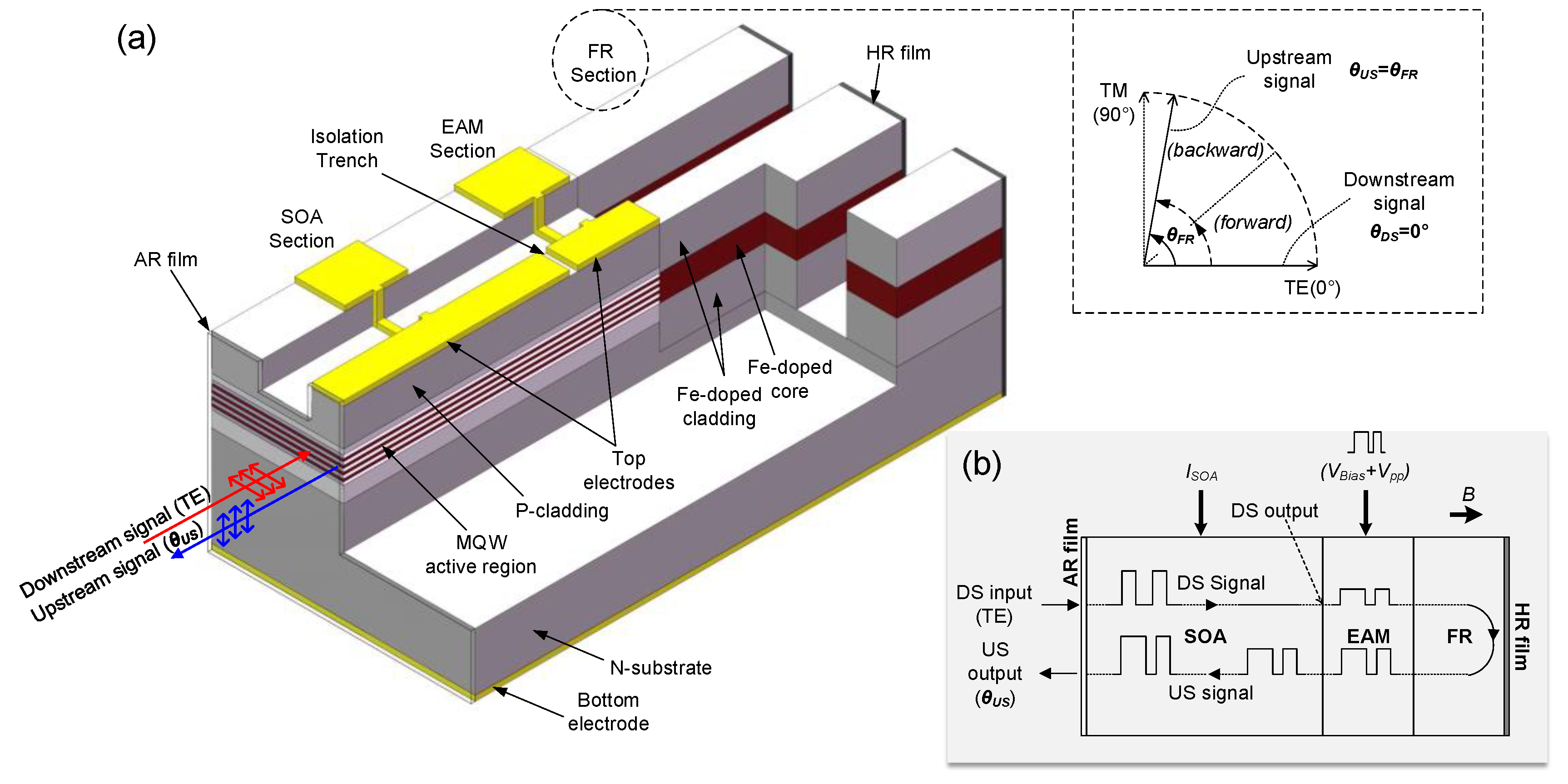
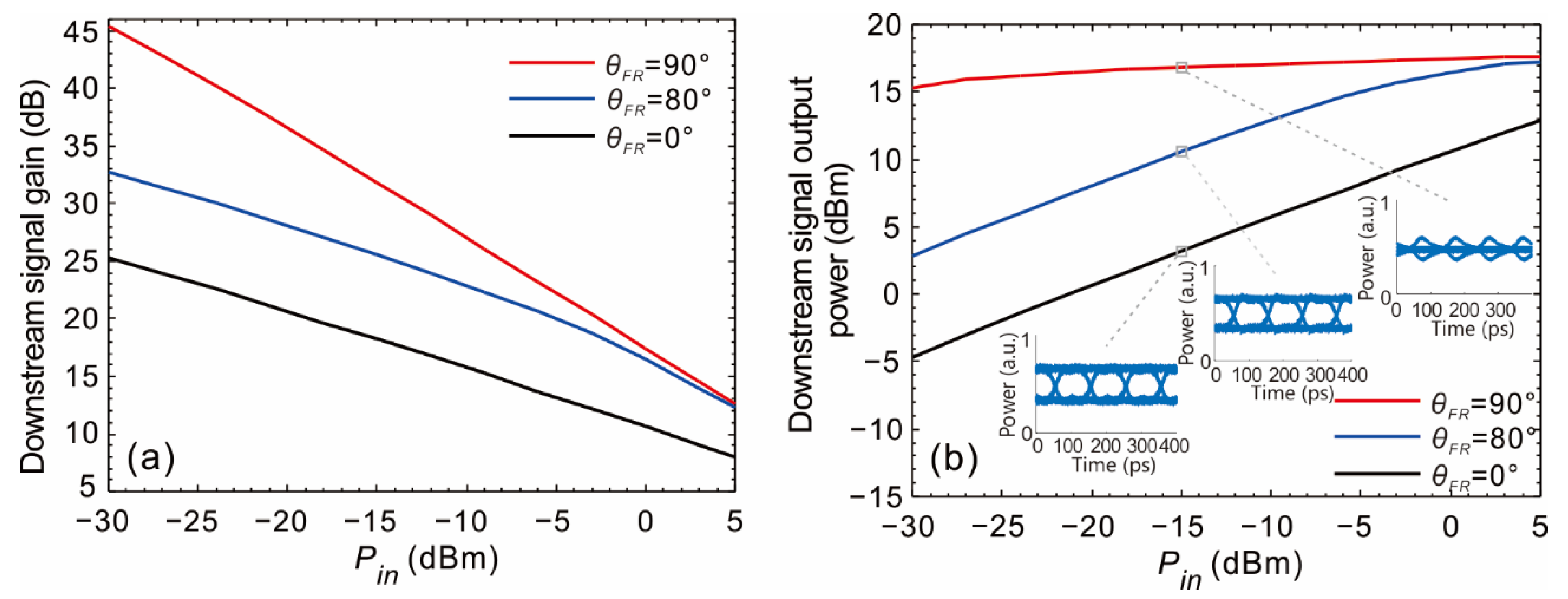
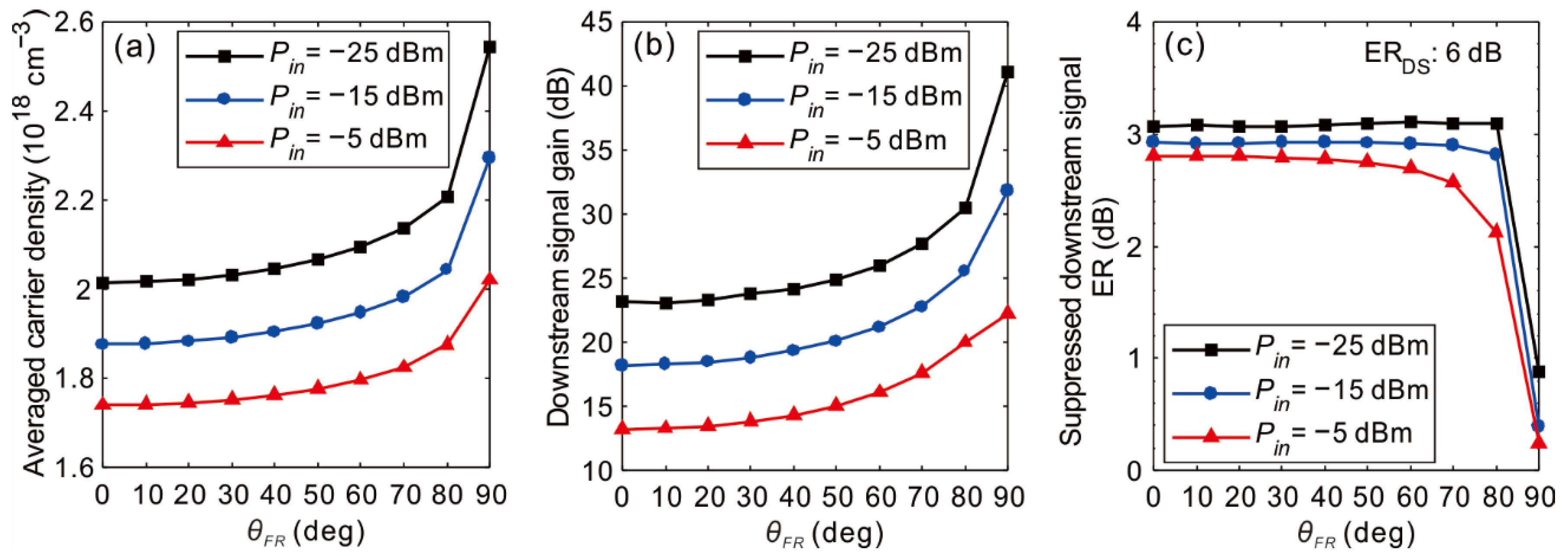
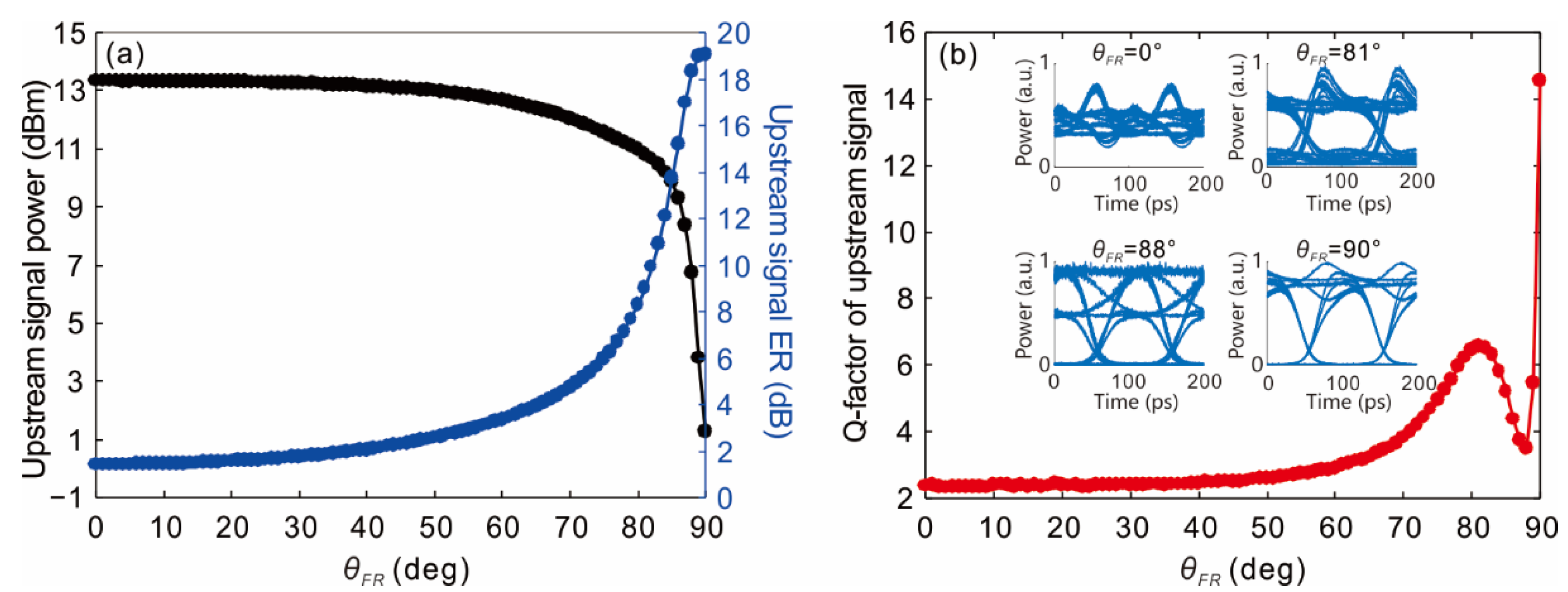
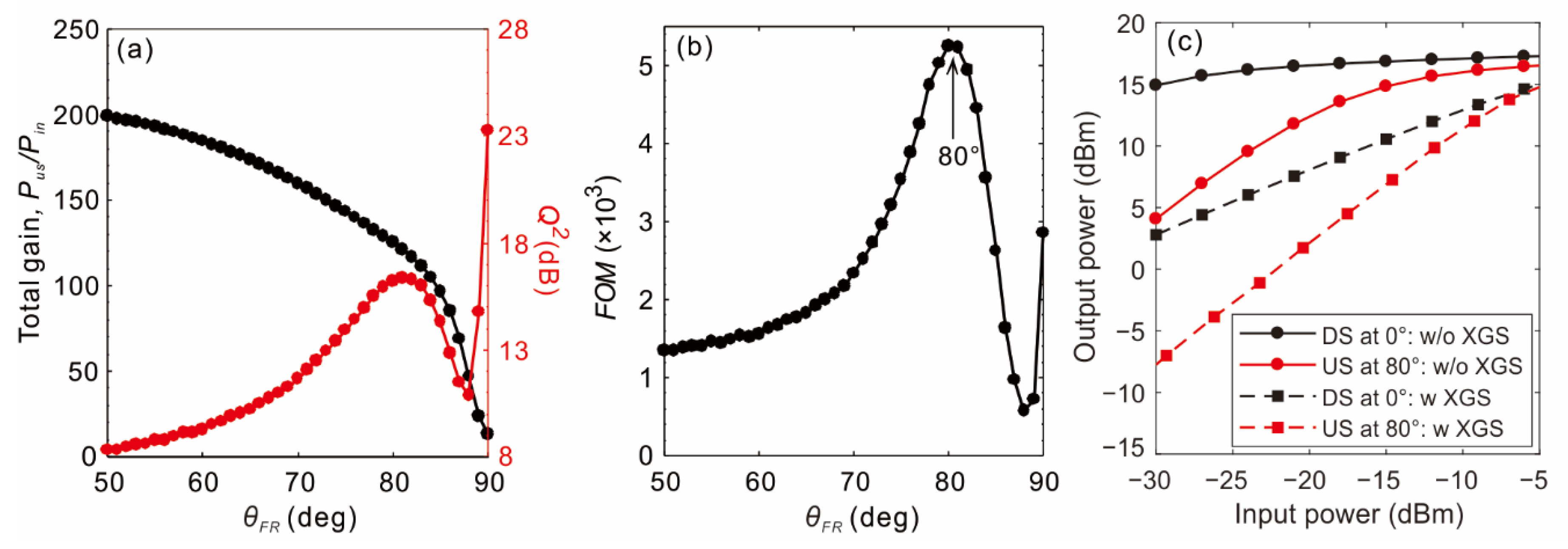
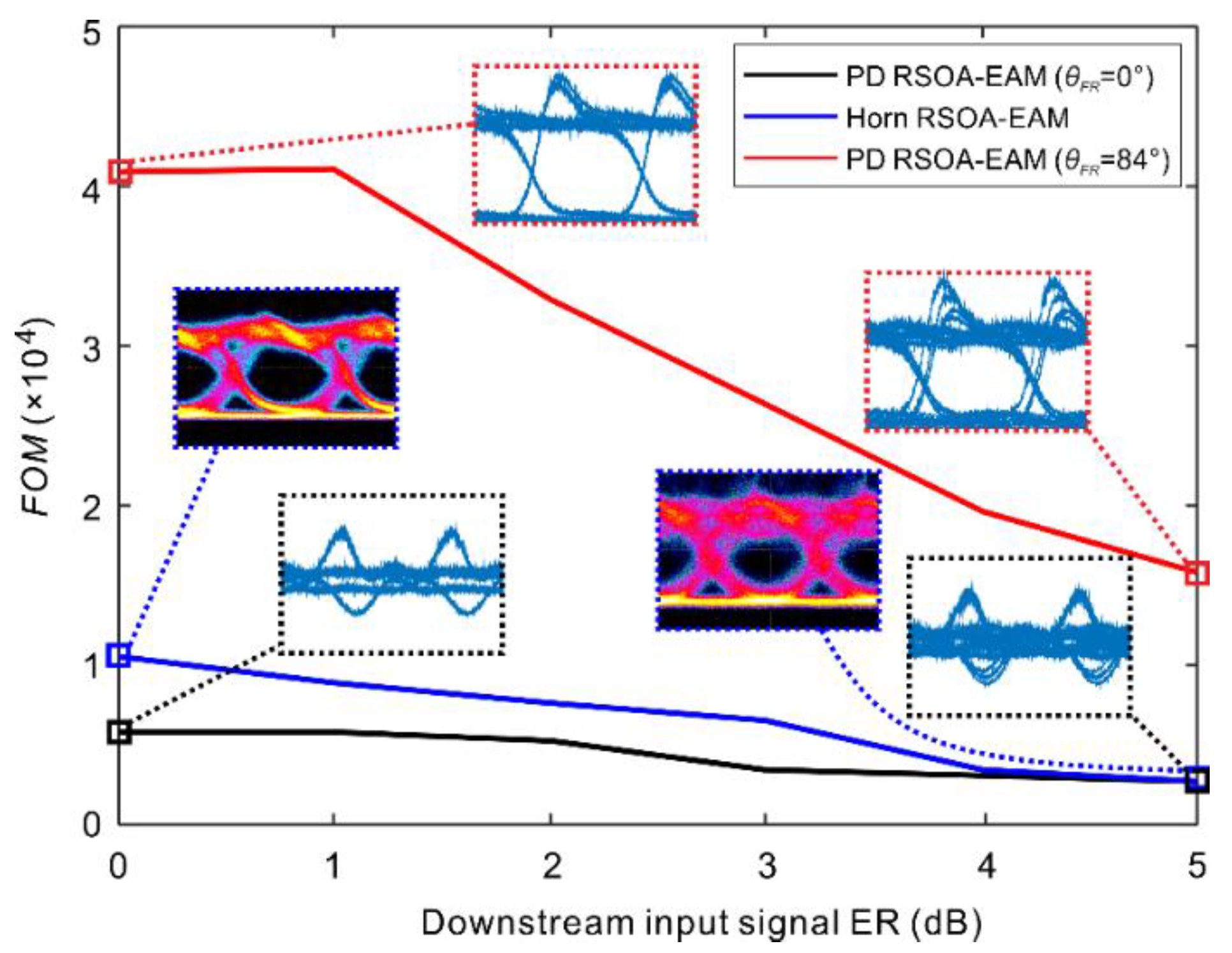
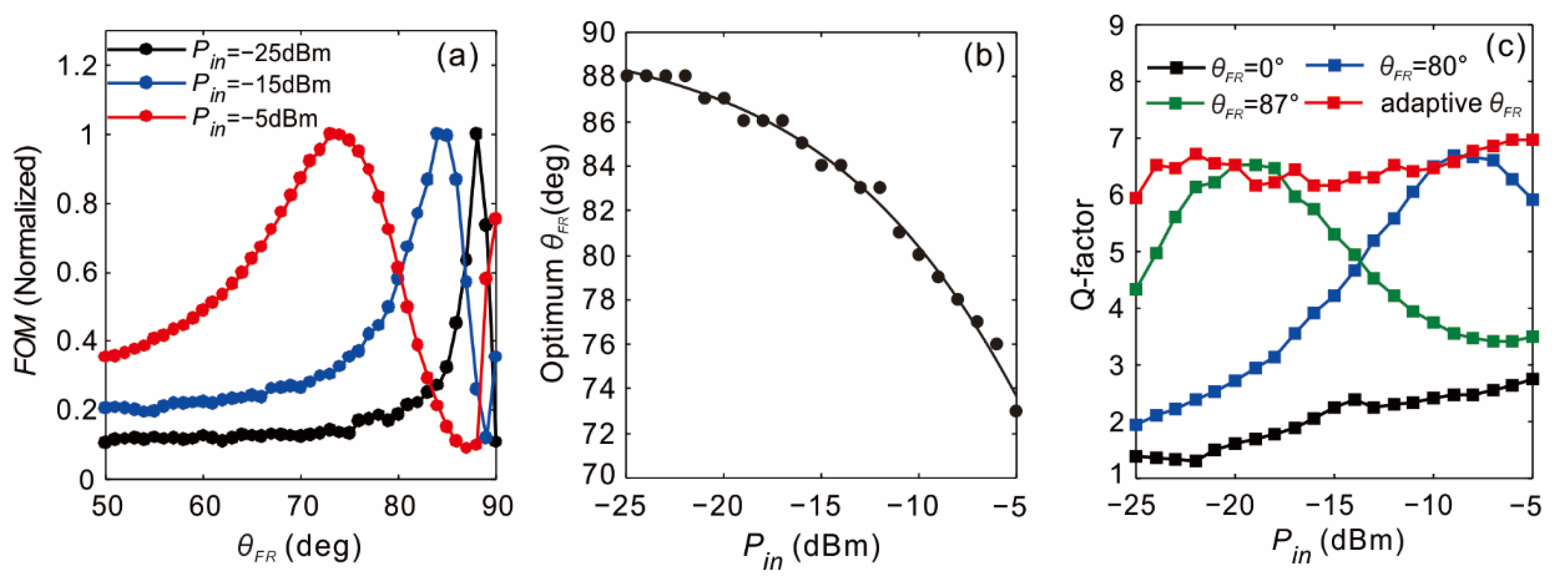
| SOA Parameters | Value | EAM/FR Parameters | Value |
|---|---|---|---|
| SOA length (μm) | 1200 | EAM length (μm) | 100 |
| SOA internal loss (cm−1) | 10 | EAM internal loss (cm−1) | 35 |
| Confinement factor | 5.5% [22] | EAM absorption coefficient (cm−1 V−2) | 1050 |
| Effective refractive index | 3.23 | ||
| Group refractive index | 3.57 | EAM saturation power (mW) | 20 |
| Quantum well gain coefficient g0 (cm−1) | 2400 | ||
| Transparent carrier density Ntr (1018 cm−3) | 1 | FR length (μm) | 1000 |
| Linear recombination coefficient A (109 s−1) | 0.25 | FR round-trip transmission coefficient TF | 0.82 [29] |
| Bimolecular radiation coefficient B (10−10 cm−3 s−1) | 5.6 | ||
| Auger coefficient C (10−29 cm−6 s−1) | 7.5 | Power reflectivity of the rear facet R2 | 1 |
| Linewidth enhancement factor | 3 | ||
| Noise coupling coefficient | 0.0073 [39] | ||
| Power reflectivity of the front facet R1 | 0 | ||
| Fiber-device coupling loss (dB) | 3.5 |
Publisher’s Note: MDPI stays neutral with regard to jurisdictional claims in published maps and institutional affiliations. |
© 2020 by the authors. Licensee MDPI, Basel, Switzerland. This article is an open access article distributed under the terms and conditions of the Creative Commons Attribution (CC BY) license (http://creativecommons.org/licenses/by/4.0/).
Share and Cite
Zuo, C.; Li, X. Polarization-Discriminated RSOA–EAM for Colorless Transmitter in WDM–PON. Appl. Sci. 2020, 10, 9049. https://doi.org/10.3390/app10249049
Zuo C, Li X. Polarization-Discriminated RSOA–EAM for Colorless Transmitter in WDM–PON. Applied Sciences. 2020; 10(24):9049. https://doi.org/10.3390/app10249049
Chicago/Turabian StyleZuo, Chengliang, and Xun Li. 2020. "Polarization-Discriminated RSOA–EAM for Colorless Transmitter in WDM–PON" Applied Sciences 10, no. 24: 9049. https://doi.org/10.3390/app10249049
APA StyleZuo, C., & Li, X. (2020). Polarization-Discriminated RSOA–EAM for Colorless Transmitter in WDM–PON. Applied Sciences, 10(24), 9049. https://doi.org/10.3390/app10249049




